‘We’ve been abandoned’: a decade later, Deepwater Horizon still haunts Mexico
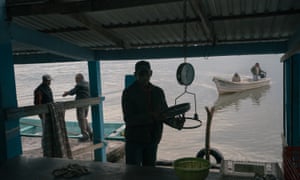

A merchant weighs shrimp while fishermen talk and arrive to sell product by the edge of a lagoon in Tamiahua, Veracruz, on 27 February. Photograph: Luis Antonio Rojas/The Guardian
by Nina Lakhani in Saladero, Veracruz Sun 19 Apr 2020
Erica Ríos Martínez grew-up in a riverside community filled with food and fiestas thanks to a booming fishing industry which supported tens of thousands of families across the Gulf of Mexico.
After high school, Ríos Martínez moved to a nearby town for college which she financed by selling blue crabs, shrimp and tilapia fished by her father in the Tamiahua lagoon – an elongated coastal inlet famed for its abundant shellfish.
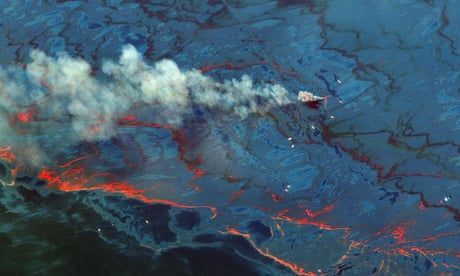
Deepwater Horizon disaster had much worse impact than believed, study finds
But fish stocks began to decline in 2011 across the Gulf – the year after BP’s Deepwater Horizon drilling rig exploded 200 miles north of Mexican territory. The offshore rig sank and released almost 5m barrels of crude oil into the Gulf of Mexico over 87 days. Oil plumes coated hundreds of miles of shoreline, causing catastrophic damage to marine life, coral reefs and birds.
Amid public and political outrage in the US, BP took full responsibility for the worst oil spill of the 20th century, which killed 11 crew members and injured 17 others. The company has paid out $69bn, including more than $10bn to affected fishermen and businesses.
But BP denied the oil reached Mexico, claiming the ocean current propelled the huge spill in the opposite direction. However, fishermen and Mexican scientists knew this wasn’t true.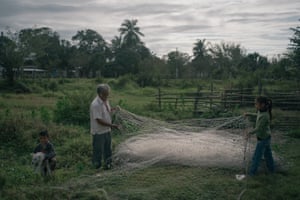
BP denied the oil reached Mexico, but fisherman and scientists knew it wasn’t true. Ten years on, Mexican communities haven’t received a cent in compensation‘I pray to God it never happens again’: US gulf coast bears scars of historic oil spill 10 years on
by Nina Lakhani in Saladero, Veracruz Sun 19 Apr 2020
Erica Ríos Martínez grew-up in a riverside community filled with food and fiestas thanks to a booming fishing industry which supported tens of thousands of families across the Gulf of Mexico.
After high school, Ríos Martínez moved to a nearby town for college which she financed by selling blue crabs, shrimp and tilapia fished by her father in the Tamiahua lagoon – an elongated coastal inlet famed for its abundant shellfish.

Deepwater Horizon disaster had much worse impact than believed, study finds
But fish stocks began to decline in 2011 across the Gulf – the year after BP’s Deepwater Horizon drilling rig exploded 200 miles north of Mexican territory. The offshore rig sank and released almost 5m barrels of crude oil into the Gulf of Mexico over 87 days. Oil plumes coated hundreds of miles of shoreline, causing catastrophic damage to marine life, coral reefs and birds.
Amid public and political outrage in the US, BP took full responsibility for the worst oil spill of the 20th century, which killed 11 crew members and injured 17 others. The company has paid out $69bn, including more than $10bn to affected fishermen and businesses.
But BP denied the oil reached Mexico, claiming the ocean current propelled the huge spill in the opposite direction. However, fishermen and Mexican scientists knew this wasn’t true.

Francisco Blanco Arango untangles a fishing with the help of her granddaughter Ada Guadalupe Blanco while Kevin Blanco Flores plays with a dog at their backyard. Photograph: Luis Antonio Rojas/The Guardian
“Before the spill we had freezers full of fish. Afterwards, my father couldn’t catch enough to support me, no matter how many hours he spent fishing. It was the same for the whole community, and it has just got worse and worse,” said Ríos Martínez, 31, who was forced to drop out of university and move away.
Ten years later, Mexican communities have not received a single cent in compensation.
“To claim the Gulf of Mexico ecosystem has borders is absurd, discriminatory and defies scientific knowledge,” said Eduardo Rubio, an expert in soil and water pollution at the College of Biologists.
Saladero is a picturesque sleepy village situated on the bank of the Papaloapan River which snakes into the south-westerly edge of the lagoon.
To claim the Gulf of Mexico ecosystem has borders is absurd, discriminatory and defies scientific knowledge Eduardo Rubio
Before the BP disaster, 95% of the village made a living – directly or indirectly – from fishing in the lagoon which stretches 65 miles from Tampico, Tamaulipas to Tuxpan, Veracruz.
The lagoon was famous for prawns and oysters fishermen recall giving away because stocks were so abundant.
Now, youngsters are forced to migrate to find factory work in maquilas in faraway cities.
“The village is full of us old people, there’s nothing for the young here any more,” said Juan Mar Aran, 78, a fisherman for 60 years. “Before, we worked hard and had money in our pockets, now we depend on our children, even the dogs are skinny. It’s very unjust, we’ve been completely abandoned.”
“Before the spill we had freezers full of fish. Afterwards, my father couldn’t catch enough to support me, no matter how many hours he spent fishing. It was the same for the whole community, and it has just got worse and worse,” said Ríos Martínez, 31, who was forced to drop out of university and move away.
Ten years later, Mexican communities have not received a single cent in compensation.
“To claim the Gulf of Mexico ecosystem has borders is absurd, discriminatory and defies scientific knowledge,” said Eduardo Rubio, an expert in soil and water pollution at the College of Biologists.
Saladero is a picturesque sleepy village situated on the bank of the Papaloapan River which snakes into the south-westerly edge of the lagoon.
To claim the Gulf of Mexico ecosystem has borders is absurd, discriminatory and defies scientific knowledge Eduardo Rubio
Before the BP disaster, 95% of the village made a living – directly or indirectly – from fishing in the lagoon which stretches 65 miles from Tampico, Tamaulipas to Tuxpan, Veracruz.
The lagoon was famous for prawns and oysters fishermen recall giving away because stocks were so abundant.
Now, youngsters are forced to migrate to find factory work in maquilas in faraway cities.
“The village is full of us old people, there’s nothing for the young here any more,” said Juan Mar Aran, 78, a fisherman for 60 years. “Before, we worked hard and had money in our pockets, now we depend on our children, even the dogs are skinny. It’s very unjust, we’ve been completely abandoned.”
A monument to the fishermen stands in the front of a gasoline station from Pemex, the Mexican state-owned petroleum company, in Tuxpan, Veracruz. Photograph: Luis Antonio Rojas/The Guardian
In 2010, the Saladero fishing cooperative registered 11,663kg of shrimp, 36kg of bass and 281,125kg of oysters. The decline has not been linear and publicly available official data is inconclusive, but in 2019, the co-op registered only 1,000kg of shrimp, 20kg of bass, and no oysters.
“The American fishermen supported by President Obama were properly compensated whereas we’ve been mocked, humiliated and discriminated against by British [Petroleum] … and let down by our own government. Ten years of struggle and nothing,” said Enrique Aran, 62, president of the cooperative.
In Tamiahua, a small town across the lagoon, Eduviges Mendoza lit a cigarette on his small fishing boat, parked beside a row of wooden poles waiting for shrimp to fill his small net.
It’s dusk, and chilly as Mendoza, 53, settled in for a second consecutive night on the lagoon with only a ratty blanket and a waterproof onesie for warmth. “There’s less fish, nobody can deny that. I’m lucky if I make enough to cover the petrol.”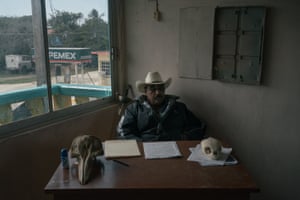
In 2010, the Saladero fishing cooperative registered 11,663kg of shrimp, 36kg of bass and 281,125kg of oysters. The decline has not been linear and publicly available official data is inconclusive, but in 2019, the co-op registered only 1,000kg of shrimp, 20kg of bass, and no oysters.
“The American fishermen supported by President Obama were properly compensated whereas we’ve been mocked, humiliated and discriminated against by British [Petroleum] … and let down by our own government. Ten years of struggle and nothing,” said Enrique Aran, 62, president of the cooperative.
In Tamiahua, a small town across the lagoon, Eduviges Mendoza lit a cigarette on his small fishing boat, parked beside a row of wooden poles waiting for shrimp to fill his small net.
It’s dusk, and chilly as Mendoza, 53, settled in for a second consecutive night on the lagoon with only a ratty blanket and a waterproof onesie for warmth. “There’s less fish, nobody can deny that. I’m lucky if I make enough to cover the petrol.”

Enrique Aran Blanco, president for more than 20 years of the fishing cooperative of Saladero, sits in his office in front of a sword that was given symbolically by a lawyer working along them against BP, and beside skulls of a dolphin and a tortoise found dead at the beach about five years after the oil spill. Photograph: Luis Antonio Rojas/The Guardian
Despite such sentiments BP has claimed that aerial images prove the oil spill’s impact was contained in US waters.
Yet back in 2011, Sergio Jiménez, a leading government oceanographer in Tamaulipas state, discovered the BP oil fingerprint more than 200 metres below sea level. Hydrocarbon fingerprints, like human ones, are unique.
The oil from Deepwater Horizon was propelled south by the deep underwater current – distinct from the surface current, according to Jiménez, who in 2013 testified in a Louisiana court tasked with managing hundreds of claims against BP.
But the case was dismissed after the court ruled that Mexico’s lawsuit, filed by the then president, Enrique Peña Nieto, just days before the deadline, superseded individual state claims.
The case trundled along until in 2018, the Mexican government withdrew the lawsuit and settled the case for $25.5m – absolving BP from responsibility for polluting Mexican waters. The secret deal, exposed in a joint investigation by BuzzFeed and the transparency group Poder, means the company no longer faces claims by any Mexican government entity.
Around the same time, the outgoing President Peña Nieto made several multimillion-dollar deals with BP. Hundreds of the company’s petrol stations have opened across the country.
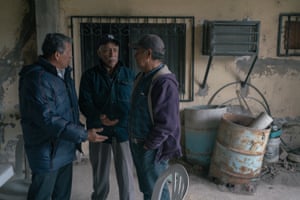
Despite such sentiments BP has claimed that aerial images prove the oil spill’s impact was contained in US waters.
Yet back in 2011, Sergio Jiménez, a leading government oceanographer in Tamaulipas state, discovered the BP oil fingerprint more than 200 metres below sea level. Hydrocarbon fingerprints, like human ones, are unique.
The oil from Deepwater Horizon was propelled south by the deep underwater current – distinct from the surface current, according to Jiménez, who in 2013 testified in a Louisiana court tasked with managing hundreds of claims against BP.
But the case was dismissed after the court ruled that Mexico’s lawsuit, filed by the then president, Enrique Peña Nieto, just days before the deadline, superseded individual state claims.
The case trundled along until in 2018, the Mexican government withdrew the lawsuit and settled the case for $25.5m – absolving BP from responsibility for polluting Mexican waters. The secret deal, exposed in a joint investigation by BuzzFeed and the transparency group Poder, means the company no longer faces claims by any Mexican government entity.
Around the same time, the outgoing President Peña Nieto made several multimillion-dollar deals with BP. Hundreds of the company’s petrol stations have opened across the country.

Norberto Hernández Cruz, centre, representative of fishermen who do not belong to cooperatives, speaks with Carlos Zárate Noguera, left, and Hermilo Martínez Durán, right, after a meeting with other representatives of fishing communities from the Gulf of Mexico in Tuxpan, Veracruz. Photograph: Luis Antonio Rojas/The Guardian
Jiménez stands by his findings and a recent study by the University of Miami backed his research, concluding that the spread of oil was far greater and more catastrophic than previously thought, as satellites and aerial images failed to detect oil at lower concentrations below the surface.
This “invisible oil” was substantial enough and toxic enough to destroy 50% of the marine life it encountered, according to Science.
It could take at least 20 to 25 years for the ecosystem to recover because of the deepwater contamination.Luis Soto
In part, this is probably due to the unprecedented quantities of toxic chemicals (dispersants) BP applied in order to stop visible oil plumes making landfall.
As a result, up to 40% of the leaked oil could still remain on the seabed. These “invisible oil” blocks will eventually break down and spread gradually over years – possibly decades – to come.
“It could take at least 20 to 25 years for the ecosystem to recover because of the deepwater contamination,” said the investigative oceanographer Luis Soto.
But scientific study, like compensation, has been massively skewed.A man weighs shrimp brought from a nearby community at a local fishermen cooperative while women wait in line to buy some for their own business. Photographs by Luis Antonio Rojas/ The Guardian
In Mexico no long-term studies monitoring the impact of the spill and the dispersants have been conducted.
By contrast in the US, a research working group created by BP conducted more than 240 studies, which cost $1.3bn in less than five years after the spill. BP also set up a $500m, 10-year program to monitor US waters just over a month after the spill and aid to restore the ecosystem.
BP has not directly funded any studies or working groups in Mexico, but the battle for justice goes on.
In Mexico, a class-action lawsuit was launched against four BP subsidiaries – two headquartered in Texas, two in Mexico – in December 2015, by an NGO working with pro bono lawyers specialising in environmental disasters.
It took two years and several court orders to track down the correct addresses of the Mexican subsidiaries in order to kickstart proceedings. Finally, in September 2019, the lawsuit was authorised to proceed despite BP’s efforts to have it dismissed, but is currently on hold since BP appealed.
Jiménez stands by his findings and a recent study by the University of Miami backed his research, concluding that the spread of oil was far greater and more catastrophic than previously thought, as satellites and aerial images failed to detect oil at lower concentrations below the surface.
This “invisible oil” was substantial enough and toxic enough to destroy 50% of the marine life it encountered, according to Science.
It could take at least 20 to 25 years for the ecosystem to recover because of the deepwater contamination.Luis Soto
In part, this is probably due to the unprecedented quantities of toxic chemicals (dispersants) BP applied in order to stop visible oil plumes making landfall.
As a result, up to 40% of the leaked oil could still remain on the seabed. These “invisible oil” blocks will eventually break down and spread gradually over years – possibly decades – to come.
“It could take at least 20 to 25 years for the ecosystem to recover because of the deepwater contamination,” said the investigative oceanographer Luis Soto.
But scientific study, like compensation, has been massively skewed.A man weighs shrimp brought from a nearby community at a local fishermen cooperative while women wait in line to buy some for their own business. Photographs by Luis Antonio Rojas/ The Guardian
In Mexico no long-term studies monitoring the impact of the spill and the dispersants have been conducted.
By contrast in the US, a research working group created by BP conducted more than 240 studies, which cost $1.3bn in less than five years after the spill. BP also set up a $500m, 10-year program to monitor US waters just over a month after the spill and aid to restore the ecosystem.
BP has not directly funded any studies or working groups in Mexico, but the battle for justice goes on.
In Mexico, a class-action lawsuit was launched against four BP subsidiaries – two headquartered in Texas, two in Mexico – in December 2015, by an NGO working with pro bono lawyers specialising in environmental disasters.
It took two years and several court orders to track down the correct addresses of the Mexican subsidiaries in order to kickstart proceedings. Finally, in September 2019, the lawsuit was authorised to proceed despite BP’s efforts to have it dismissed, but is currently on hold since BP appealed.
Eduviges Mendoza smokes a cigarette while fishing shrimp on his motorless boat, where he slept for a second night in a row, at the lagoon of Tamiahua, Veracruz. Photograph: Luis Antonio Rojas/The Guardian
“BP’s pattern has been to deny everything, and claim the class action no merit, meanwhile settling many cases worth billions of dollars in the US. The position of BP is sad, but so is the position of the Mexican government which has ignored the plight of its own people,” said lawyer Karla Borja.
In 2019, Mexico’s new president, Andrés Manuel López Obrador (Amlo), promised the fishermen a fair deal. “Amlo promised to make the company pay. But so far we’ve seen nothing but nice words and meetings,” said Aran, the co-op president.
In Louisiana, more than 110 cases involving thousands of Mexicans remain open, but have yet to be heard. Scores more have been dismissed.
In March, the fishermen leading 41 of those cases wrote to the new CEO of BP, Bernard Looney, requesting he do the right thing and compensate the Mexicans affected by the oil spill.
In a statement BP said: “All available evidence confirms that oil from the Deepwater Horizon incident did not reach Mexican waters or shorelines … We value the opportunity to do business in Mexico, and we are committed to the highest standards of conduct and full compliance with the laws.”
“BP’s pattern has been to deny everything, and claim the class action no merit, meanwhile settling many cases worth billions of dollars in the US. The position of BP is sad, but so is the position of the Mexican government which has ignored the plight of its own people,” said lawyer Karla Borja.
In 2019, Mexico’s new president, Andrés Manuel López Obrador (Amlo), promised the fishermen a fair deal. “Amlo promised to make the company pay. But so far we’ve seen nothing but nice words and meetings,” said Aran, the co-op president.
In Louisiana, more than 110 cases involving thousands of Mexicans remain open, but have yet to be heard. Scores more have been dismissed.
In March, the fishermen leading 41 of those cases wrote to the new CEO of BP, Bernard Looney, requesting he do the right thing and compensate the Mexicans affected by the oil spill.
In a statement BP said: “All available evidence confirms that oil from the Deepwater Horizon incident did not reach Mexican waters or shorelines … We value the opportunity to do business in Mexico, and we are committed to the highest standards of conduct and full compliance with the laws.”
A young mangrove stands in a lagoon near empty charangas, traps for shrimps made out of wood and fishing nets, in Saladero, Veracruz. Photograph: Luis Antonio Rojas/The Guardian
In Saladero, shortly before the 10th anniversary of the disaster, about 150 people turned out for the town hall-style meeting, to share stories of hardship resulting from the demise of the lagoon which has divided families and crushed educational and career ambitions.
The primary school has fewer than 30 enrolled pupils, compared with more than a hundred before the spill. The only gas station shut down and abandoned boats dot the riverbank.
Numerous parents said they were forced to pull their children out of college so they could start work and send home remittances to support the family.
“There’s no money because there’s no fish, that’s why all our young people leave,” said Juana Constantino, 59, who cares for her grandson while her daughter works in a maquila in Reynosa, one of Mexico’s most dangerous border towns. “We need compensation, we want justice.”
In Saladero, shortly before the 10th anniversary of the disaster, about 150 people turned out for the town hall-style meeting, to share stories of hardship resulting from the demise of the lagoon which has divided families and crushed educational and career ambitions.
The primary school has fewer than 30 enrolled pupils, compared with more than a hundred before the spill. The only gas station shut down and abandoned boats dot the riverbank.
Numerous parents said they were forced to pull their children out of college so they could start work and send home remittances to support the family.
“There’s no money because there’s no fish, that’s why all our young people leave,” said Juana Constantino, 59, who cares for her grandson while her daughter works in a maquila in Reynosa, one of Mexico’s most dangerous border towns. “We need compensation, we want justice.”
---30---
SEE
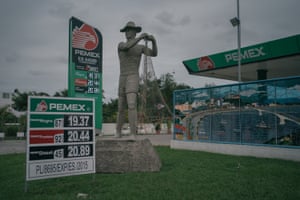
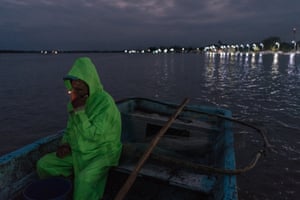
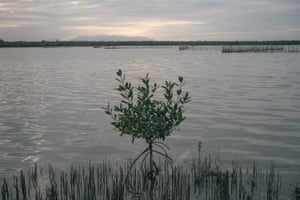
No comments:
Post a Comment